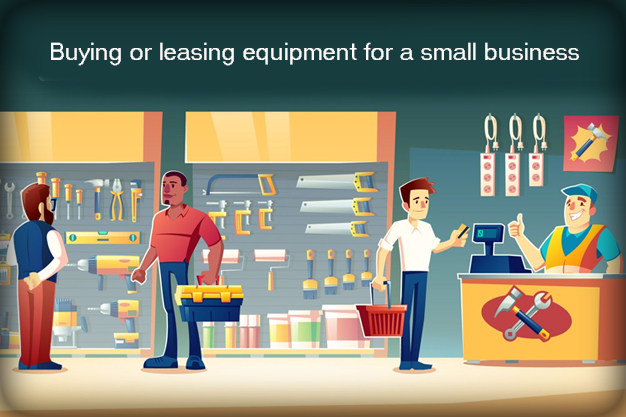
Deciding whether to lease or buy equipment is a common challenge for small business owners. Leasing offers flexibility and lower upfront costs, while buying provides ownership and potential long-term savings. Consider your needs and financial situation to make the best choice for your business’s success.
Understanding the Difference: Leasing vs Buying
When getting equipment for your small business, you can lease or buy. Leasing is like renting—you pay regular fees for a set time. At the end, you can return the equipment, renew the lease, or buy it at a set price. Buying means you own the equipment outright, either with cash or a loan. You’re responsible for its upkeep and disposal.
Leasing Equipment vs Buying Equipment
Leasing equipment is great for small businesses with limited upfront money or unsure equipment needs. It has some advantages and disadvantages:
Pros of Leasing Equipment
- Lower upfront costs: Leasing allows you to get the equipment you need without a significant upfront investment. Instead of paying the full buy price, you can spread the cost over monthly lease payments. This frees up your working capital for other business needs.
- Flexibility to upgrade: Leasing lets you use the newest equipment without owning it. You can upgrade to newer models when your lease ends, keeping your business competitive.
- Maintenance and repairs included: Leasing usually covers maintenance and repairs, saving you from unexpected costs and downtime.
Cons of Leasing Equipment
- Higher cost: While leasing may have lower upfront costs, it can be more expensive in the long run. Over the duration of the lease, you may end up paying more than the equipment’s actual value. Additionally, lease payments are not tax-deductible in the same way as interest payments on a loan.
- Limited ownership and control: Leasing means you don’t own the equipment or control it. You have to follow the leasing company’s rules, including usage restrictions. Not owning the equipment also means you can’t use it as collateral for loans.
- Potential for lease obligations: The lease agreement may lock you into a long-term commitment, which can make it challenging to adapt to changing business needs. Terminating a lease early can result in penalties or more costs.
Purchasing equipment outright offers different advantages and disadvantages compared to leasing. Let’s explore the pros and cons of buying equipment for your small business:
Pros of Buying Equipment
- Ownership and control: When you buy equipment, you have complete ownership and control over it. You can use the equipment as you see fit, change it to suit your specific needs, and even sell it if it’s no longer required. Owning equipment also allows you to use it as collateral for future financing.
- Potential for cost savings: While buying equipment requires a higher upfront investment, it can lead to long-term cost savings. Once you’ve paid off the buy price, you no longer have ongoing lease payments. Additionally, you may be able to deduct depreciation expenses and interest on any loans used to finance the buy.
- Flexibility and adaptability: With ownership comes the freedom to adapt to changing business needs. You can use the equipment for as long as it remains functional and suits your requirements. There are no lease terms or restrictions that dictate when you can upgrade or replace the equipment.
Cons of Buying Equipment
- Higher upfront costs: Purchasing equipment outright often requires a significant upfront investment. This can strain your working capital, especially if you’re a small business with limited financial resources. Buying may not be workable if you need many pieces of expensive equipment.
- Risk of obsolescence: Technology advances, and the equipment you buy today may become outdated in a few years. This can result in a depreciating asset that is difficult to resell or repurpose. Upgrading or disposing of obsolete equipment can be costly and time-consuming.
- Maintenance and repair expenses: As the equipment owner, you are responsible for all maintenance, repair, and replacement costs. Depending on the equipment type, these expenses can add up over time, impacting your budget and cash flow.
Factors to Consider Before Making a Decision
Now, let’s look at some key factors to help you decide whether to lease or buy equipment for your small business:
- Budget and cash flow
- Equipment lifespan and obsolescence
- Business growth and flexibility
- Tax implications
- Equipment usage and customization
Making the Right Choice for Your Small Business
Think about what your business needs, your finances, and where you see your business going. Talking to experts, at Business Capital USA, can help you understand your financing options. The right choice is one that fits your business goals and sets you up for success. Many use Business Capital USA’s cash advance service.
Business Capital USA knows that cash flow is crucial for businesses. When new opportunities arise, having the right equipment is important. That’s where a business cash advance can help. It’s a quick and easy way to get the money you need for machinery, computers, vehicles, or anything else your small business needs. Business Capital USA offers capital to help you get equipment faster and more.
With a business cash advance, you can qualify for up to $2 million in equipment financing. If your small business has been operating for at least a year and makes $15,000 in monthly sales, you can qualify. Plus, unlike small business equipment loans from banks, you don’t need personal collateral or extensive documentation. Apply online and get your business cash advance within one business day to meet your equipment needs.
